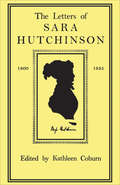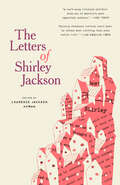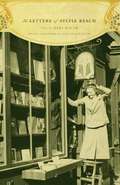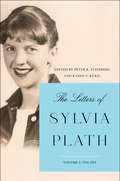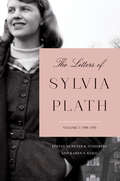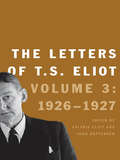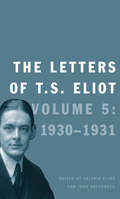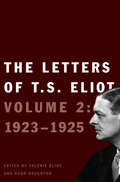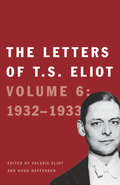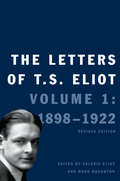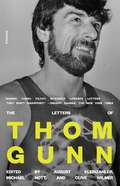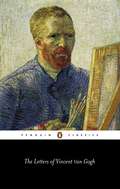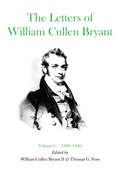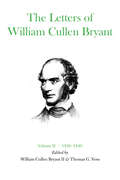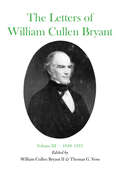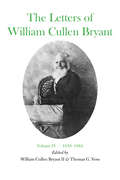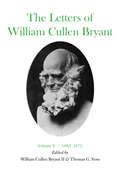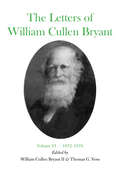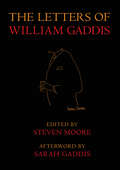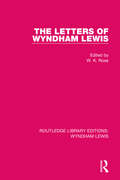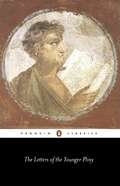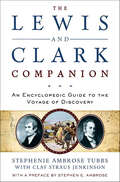- Table View
- List View
The Letters of Sara Hutchinson
by Kathleen Coburn Sara HutchinsonSarah Hutchinson has never been much more than a name, though a name connected with some of the greatest in English literature. The sister of Mrs. Wordsworth, and a member of the Wordsworth household for thirty years, Coleridge's beloved Asra to whom many of his poems were written, Southey's friend and Lamb's, and a guest of the Arnolds at Rugby, she was a member of an interesting circle. For her intimate relations to Wordsworth and Coleridge it has long been apparent that we should like to know her better. Now her letters to members of her family and to friends demonstrate how worthwhile it is to know her for herself as well.<P><P>The letters come from the family and from the Wordsworth collection at Dove Cottage and are here printed (almost in full) for the first time.<P>They show a lively and amusing woman, kind, forthright to the extent of bluntness, especially when she takes up the cudgels in the cause of what she considers truth or justice or human kindness. Coleridge describes her in one apt and characteristic sentence: <P>'If Sense, Sensibility, Sweetness of Temper, perfect simplicity and unpretending Nature, joined to shrewdness and entertainingness make a valuable Woman, Sara Hutchinson is so.'<P>Such qualities certainly make a delightful letter-writer.
The Letters of Seamus Heaney
by Seamus HeaneyThe letters provide us with an intimate, multilayered understanding of this extraordinary poet’s life and mind.Every now and again I need to get down here, to get into the Diogenes tub, as it were, or the Colmcille beehive hut, or the Mossbawn scullery. At any rate, a hedge surrounds me, the blackbird calls, the soul settles for an hour or two.In this astute selection from Seamus Heaney’s vast correspondence, we are given direct access to the life and poetic development of a literary titan, from his early days in Belfast, through his controversial decision to settle in the Republic, to the gradual broadening of horizons that culminated in the award of the Nobel Prize in Literature and the years of international eminence that kept him heroically busy until his death.Christopher Reid draws from both public and private archives to reveal this remarkable story in the poet’s own words. Generous, funny, exuberant, confiding, irreverent, empathetic, and deeply thoughtful, The Letters of Seamus Heaney encompasses decades-long relationships with friends and colleagues, as well as an unstinted responsiveness to passing acquaintances.Heaney’s mastery of language is as evident here as it is in any of his writings; listening to his voice we find ourselves in the same room as a man whose presence enriched the world and whose legacy deepens our sense of what truly matters.
The Letters of Shirley Jackson
by Shirley JacksonA bewitchingly brilliant collection of never-before-published letters from the renowned author of &“The Lottery&” and The Haunting of Hill House&“This biography-through-letters gives an intimate and warm voice to the imagination behind the treasury of uncanny tales that is Shirley Jackson&’s legacy.&”—Joyce Carol OatesShirley Jackson is one of the most important American authors of the last hundred years and among our greatest chroniclers of the female experience. This extraordinary compilation of personal correspondence has all the hallmarks of Jackson&’s beloved fiction: flashes of the uncanny in the domestic, sparks of horror in the quotidian, and the veins of humor that run through good times and bad.i am having a fine time doing a novel with my left hand and a long story—with as many levels as grand central station—with my right hand, stirring chocolate pudding with a spoon held in my teeth, and tuning the television with both feet.Written over the course of nearly three decades, from Jackson&’s college years to six days before her early death at the age of forty-eight, these letters become the autobiography Shirley Jackson never wrote. As well as being a bestselling author, Jackson spent much of her adult life as a mother of four in Vermont, and the landscape here is often the everyday: raucous holidays and trips to the dentist, overdue taxes and frayed lines of Christmas lights, new dogs and new babies. But in recounting these events to family, friends, and colleagues, she turns them into remarkable stories: entertaining, revealing, and wise. At the same time, many of these letters provide fresh insight into the genesis and progress of Jackson&’s writing over nearly three decades.The novel is getting sadder. It&’s always such a strange feeling—I know something&’s going to happen, and those poor people in the book don&’t; they just go blithely on their ways.Compiled and edited by her elder son, Laurence Jackson Hyman, in consultation with Jackson scholar Bernice M. Murphy and featuring Jackson&’s own witty line drawings, this intimate collection holds the beguiling prism of Shirley Jackson—writer and reader, mother and daughter, neighbor and wife—up to the light.
The Letters of Sylvia Beach
by Sylvia Beach Keri Walsh No?l Riley FitchFounder of the Left Bank bookstore Shakespeare and Company and the first publisher of James Joyce's Ulysses, Sylvia Beach had a legendary facility for nurturing literary talent. In this first collection of her letters, we witness Beach's day-to-day dealings as bookseller and publisher to expatriate Paris. Friends and clients include Ernest Hemingway, Gertrude Stein, H. D. , Ezra Pound, Janet Flanner, William Carlos Williams, F. Scott Fitzgerald, James Joyce, and Richard Wright. As librarian, publicist, publisher, and translator, Beach carved out a unique space for herself in English and French letters. This collection reveals Beach's charm and resourcefulness, sharing her negotiations with Marianne Moore to place Joyce's work in The Dial; her battle to curb the piracy of Ulyssesin the United States; her struggle to keep Shakespeare and Company afloat during the Depression; and her complicated affair with the French bookstore owner Adrienne Monnier. These letters also recount Beach's childhood in New Jersey; her work in Serbia with the American Red Cross; her internment in a German prison c& and her friendship with a new generation of expatriates in the 1950s and 1960s. Beach was the consummate American in Paris and a tireless champion of the avant-garde. Her warmth and wit made the Rue de l'Od on the heart of modernist Paris.
The Letters of Sylvia Beach
by Sylvia BeachFounder of the Left Bank bookstore Shakespeare and Company and the first publisher of James Joyce's Ulysses, Sylvia Beach had a legendary facility for nurturing literary talent. In this first collection of her letters, we witness Beach's day-to-day dealings as bookseller and publisher to expatriate Paris. Friends and clients include Ernest Hemingway, Gertrude Stein, H. D., Ezra Pound, Janet Flanner, William Carlos Williams, F. Scott Fitzgerald, James Joyce, and Richard Wright. As librarian, publicist, publisher, and translator, Beach carved out a unique space for herself in English and French letters. This collection reveals Beach's charm and resourcefulness, sharing her negotiations with Marianne Moore to place Joyce's work in The Dial; her battle to curb the piracy of Ulysses in the United States; her struggle to keep Shakespeare and Company afloat during the Depression; and her complicated affair with the French bookstore owner Adrienne Monnier. These letters also recount Beach's childhood in New Jersey; her work in Serbia with the American Red Cross; her internment in a German prison camp; and her friendship with a new generation of expatriates in the 1950s and 1960s. Beach was the consummate American in Paris and a tireless champion of the avant-garde. Her warmth and wit made the Rue de l'Odéon the heart of modernist Paris.
The Letters of Sylvia Plath Vol 2: 1956-1963
by Sylvia Plath"A scintillating and poignant autobiography in letters. . . . Her letters blaze with fresh and stunning revelations, with more to come."—Booklist on The Letters of Sylvia Plath Vol 1The second volume in the definitive, complete collection of the letters of Pulitzer Prize-winning poet, Sylvia Plath, from the early years of her marriage to Ted Hughes to the final days leading to her suicide in 1963, many never before seen.One of the most talented and beloved poets, Sylvia Plath continues to fascinate and inspire the modern literary imagination. The tragedy of her untimely death at age thirty, almost fifty-five years ago, has left much unknown about her creative and personal life. In this remarkable second volume of the iconic poet and writer’s collected letters, the full range of Plath’s ambitions, talents, fears, and perspective is made visible through her own powerful words.As engaging as they are revealing, these remarkable letters cover the years from 1957 to 1963. They detail the last six tumultuous and prolific years of her life, covering her marriage to Ted Hughes, the births of her children Frieda and Nicholas, her early success, including the publication of the classic The Bell Jar, and her ongoing struggle with depression.The first compendium of its kind to include all of Plath’s letters from this period, The Letters of Sylvia Plath Volume 2 offers an intimate portrait of the writing life and mind of one of the most celebrated poets in literary history.
The Letters of Sylvia Plath Volume 1: 1940-1956
by Sylvia PlathA major literary event: the first volume in the definitive, complete collection of the letters of Sylvia Plath—most never before seen.One of the most beloved poets of the modern age, Sylvia Plath continues to inspire and fascinate the literary world. While her renown as one of the twentieth century’s most influential poets is beyond dispute, Plath was also one of its most captivating correspondents. The Letters of Sylvia Plath is the breathtaking compendium of this prolific writer’s correspondence with more than 120 people, including family, friends, contemporaries, and colleagues. The Letters of Sylvia Plath includes her correspondence from her years at Smith, her summer editorial internship in New York City, her time at Cambridge, her experiences touring Europe, and the early days of her marriage to Ted Hughes in 1956.Most of the letters are previously unseen, including sixteen letters written by Plath to Hughes when they were apart after their honeymoon. This magnificent compendium also includes twenty-seven of Plath’s own elegant line drawings taken from the letters she sent to her friends and family, as well as twenty-two previously unpublished photographs. This remarkable, collected edition of Plath’s letters is a work of immense scholarship and care, presenting a comprehensive and historically accurate text of the known and extant letters that she wrote. Intimate and revealing, this masterful compilation offers fans and scholars generous and unprecedented insight into the life of one of our most significant poets.
The Letters of T. S. Eliot
by Valerie Eliot John HaffendenIn the period covered by this richly detailed collection, which brings the poet to the age of forty, T. S. Eliot was to set a new course for his life and work. Forsaking the Unitarianism of his American forebears, he was received into the Church of England and naturalised as a British citizen - a radical and public alteration of the intellectual and spiritual direction of his career. The demands of Eliot's professional life as writer and editor became more complex and exacting during these years. The celebrated but financially-pressed periodical he had been editing since 1922 - The Criterion - switched between being a quarterly and a monthly, before being rescued by the fledgling house of Faber & Gwyer. In addition to writing numerous essays and editorials, lectures, reviews, introductions and prefaces, his letters show Eliot involving himself wholeheartedly in the business of his new career as a publisher. His Ariel poems, Journey of the Magi (1927) and A Song for Simeon (1928) established a new manner and vision for the poet of The Waste Land and 'The Hollow Men'. These are also the years in which Eliot published two sections of an exhilaratingly funny, savage, jazz-influenced play-in-verse - 'Fragment of a Prologue' and 'Fragment of an Agon' - which were subsequently brought together as Sweeney Agonistes. In addition, he struggled to translate the remarkable work Anabase, by St. -John Perse, which was to be a signal influence upon his own later poetry. This correspondence with friends and mentors vividly documents all the stages of Eliot's personal and artistic transformation during these crucial years, the continuing anxieties of his private life, and the forging of his public reputation.
The Letters of T. S. Eliot
by T. S. EliotThis fifth volume of the collected letters of poet, playwright, essayist, and literary critic Thomas Stearns Eliot covers the years 1930 through 1931. It was during this period that the acclaimed American-born writer earnestly embraced his newly avowed Anglo-Catholic faith, a decision that earned him the antagonism of friends like Virginia Woolf and Herbert Read. Also evidenced in these correspondences is Eliot's growing estrangement from his wife Vivien, with the writer's newfound dedication to the Anglican Church exacerbating the unhappiness of an already tormented union. Yet despite his personal trials, this period was one of great literary activity for Eliot. In 1930 he composed the poems Ash-Wednesday and Marina, and published Coriolan and a translation of Saint-John Perse's Anabase the following year. As director at the British publishing house Faber & Faber and editor of The Criterion, he encouraged W. H. Auden, Stephen Spender, Louis MacNeice, and Ralph Hogdson, published James Joyce's Haveth Childers Everywhere, and turned down a book proposal from Eric Blair, better known by his pen name, George Orwell. Through Eliot's correspondences from this time the reader gets a full-bodied view of a great artist at a personal, professional, and spiritual crossroads.
The Letters of T. S. Eliot Volume 2
by John HaffendenVolume Two: 1923–1925 covers the early years of Eliot's editorship of The Criterion, publication of The Hollow Men, and his developing thought about poetry and poetics. The volume offers 1,400 letters, charting Eliot's journey toward conversion to the Anglican faith, as well as his transformation from banker to publisher and his appointment as director of the new publishing house Faber & Gwyer. The prolific and various correspondence in this volume testifies to Eliot's growing influence as cultural commentator and editor.
The Letters of T. S. Eliot: 19321933
by T. S. Eliot Valerie Eliot John HaffendenThe letters between Eliot and his associates, family and friends - his correspondents range from the Archbishop of York and the American philosopher Paul Elmer More to the writers Virginia Woolf, Herbert Read and Ralph Hodgson - serve to illuminate the ways in which his Anglo-Catholic convictions could, at times, prove a self-chastising and even alienating force. 'Anyone who has been moving among intellectual circles and comes to the Church, may experience an odd and rather exhilarating feeling of isolation,' he remarks. Notwithstanding, he becomes fully involved in doctrinal controversy: he espouses the Church as an arena of discipline and order. Eliot's relationship with his wife, Vivien, continues to be turbulent, and at times desperate, as her mental health deteriorates and the communication between husband and wife threatens, at the coming end of the year, to break down completely. At the close of this volume Eliot will accept a visiting professorship at Harvard University, which will take him away from England and Vivien for the academic year 1932-33.
The Letters of T.S. Eliot Volume 1
by Valerie Eliot Hugh HaughtonVolume One of the Letters of T.S. Eliot, edited by Valerie Eliot in 1988, covered the period from Eliot's childhood in St Louis, Missouri, to the end of 1922, by which time he had settled in England, married and published The Waste Land. Since 1988, Valerie Eliot has continued to gather materials from collections, libraries and private sources in Britain and America, towards the preparation of subsequent volumes of the Letters edition. Among new letters to have come to light, a good many date from the years 1898-1922, which has necessitated a revised edition of Volume One, taking account of approximately two hundred newly discovered items of correspondence. The new letters fill crucial gaps in the record, notably enlarging our understanding of the genesis and publication of The Waste Land. Valuable, too, are letters from the earlier and less documented part of Eliot's life, which have been supplemented by additional correspondence from family members in America.
The Letters of Thom Gunn
by Thom GunnThe Letters of Thom Gunn presents the first complete portrait of the private life, reflections, and relationships of a maverick figure in the history of British and American poetry. “I write about love, I write about friendship,” remarked Thom Gunn. “I find that they are absolutely intertwined.” These core values permeate his correspondence with friends, family, lovers, and fellow poets, and they shed new light on “one of the most singular and compelling poets in English during the past half-century” (Hugh Haughton, The Times Literary Supplement). The Letters of Thom Gunn, edited by August Kleinzahler, Michael Nott, and Clive Wilmer, reveals the evolution of Gunn’s work and illuminates the fascinating life that informed his poems: his struggle to come to terms with his mother’s suicide; settling in San Francisco and his complex relationship with England; his changing relationship with his life partner, Mike Kitay; the LSD trips that led to his celebrated collection Moly (1971); and the deaths of friends from AIDS that inspired the powerful, unsparing elegies of The Man with Night Sweats (1992).
The Letters of Vincent Van Gogh
by Vincent Van GoghA new selection of Vincent Van Gough's letters, based on an entirely new translation, revealing his religious struggles, his fascination with the French Revolution, his search for love and his involvement in humanitarian causes.
The Letters of William Cullen Bryant: Volume I, 1809–1836
by William Cullen BryantThis is the only collection ever made of Bryant's letters, two-thirds of which have never before been printed. Their publication was foreseen by the late Allan Nevin as "one of the most important and stimulating enterprises contributory to the enrichment of the nation's cultural and political life that is now within range of individual and group effort.William Cullen Bryant (1794–1878) was America's earliest national poet. His immediate followers—Longfellow, Poe, and Whitman—unquestionably began their distinguished careers in imitation of his verses. But Bryant was even more influential in his long career as a political journalist, and in his encouragement of American art, from his lectures at the National Academy of Design in 1828 to his evocation of the Metropolitan Museum of Art in 1870. Between the appearance of his first major poem, "Thanatopsis," in 1817, and his death sixty-one years later at the age of eight-three, Bryant knew and corresponded with an extraordinary number of eminent men and women. More than 2,100 of his know letters have already been recovered for the present edition.When William Cullen Bryant signed the first of 314 letters in the present volume, in 1809, he was a frail and shy farm boy of fourteen who had nonetheless already won some fame as the satirist of Thomas Jefferson. When he wrote the last, in 1836, he had become the chief poet of his country, the editor of its principal liberal newspaper, and the friend and collaborator of its leading artists and writers. His collected poems, previously published at New York, Boston, and London, were going into their third edition. His incisive editorials in the New York Evening Post were affecting the decisions of Andrew Jackson's administration. His poetic themes were beginning to find expression in the landscape paintings of Robert Weir, Asher Durand, and Thomas Cole.The early letters gathered here in chronological order give a unique picture of Cullen Bryant's youth and young manhood: his discipline in the classics preparatory to an all-too-brief college tenure; his legal study and subsequent law practice; the experiments with romantic versification which culminated in his poetic masterpieces, and those with the opposite sex which led to his courtship and marriage; his eager interest in the politics of the Madison and Monroe Presidencies, and his subsequent activities as a local politician and polemicist in western Massachusetts; his apprenticeship as magazine editor and literary critic in New York City, from which his later eminence as journalist was the natural evolution; the lectures on poetry and mythology which foreshadowed a long career as occasional orator; the collaboration in writing The Talisman, The American Landscape, and Tales of Glauber-Spa, and in forming the National Academy of Design, and the Sketch Club, which brought him intimacy with writers, artists, and publishers; his first trip to the Aemrican West, and his first long visit to Europe, during which he began the practice of writing letters to his newspaper which, throughout nearly half a century, proved him a perceptive interpreter of the distant scene to his contemporaries.Here, in essence, is the first volume of the autobiography of one whom Abraham Lincoln remarked after his first visit to New York City in 1860, "It was worth the journey to the East merely to see such a man." And John Bigelow, who of Bryant's many eulogists knew him best, said in 1878 of his longtime friend and business partner, "There was no eminent American upon whom the judgment of his countrymen would be more immediate and unanimous. The broad simple outline of his character and career had become universally familiar, like a mountain or a sea."
The Letters of William Cullen Bryant: Volume II, 1836–1849
by William Cullen BryantThe second volume of William Cullen Bryant's letters opens in 1836 as he has just returned to New York from an extended visit to Europe to resume charge of the New York Evening Post, brought near to failure during his absence by his partner William Leggett's mismanagement. At the period's close, Bryant has found in John Bigelow an able editorial associate and astute partner, with whose help he has brought the paper close to its greatest financial prosperity and to national political and cultural influence.Bryant's letters lf the years between show the versatility of his concern with the crucial political, social, artistic, and literary movements of his time, and the varied friendships he enjoyed despite his preoccupation with a controversial daily paper, and with the sustenance of a poetic reputation yet unequaled among Americans. As president of the New York Homeopathic Society, in letters and editorials urging widespread public parks, and in his presidency of the New York Society for the Abolition of the Punishment of Death, he gave attention to public health, recreation, and order. He urged the rights of labor, foreign and religious minorities, and free African Americans; his most powerful political effort of the period was in opposition to the spread of slavery through the conquest of Mexico. An early commitment to free trade in material goods was maintained in letters and editorials, and to that in ideas by his presidency of the American Copyright Club and his support of the efforts of Charles Dickens and Harriet Martineau to secure from the United States Congress and international copyright agreement.Bryant's first visit to Great Britain came at the height of his poetic and journalistic fame in 1845, bringing him into cordial intimacy with members of Parliament, scientists, journalists, artists, and writers. In detailed letters to his wife, published here for the first time, he describes the pleasures he took in breakfasting with the literary patron Samuel Rogers and the American minister Edward Everett, boating on the Thames with artists and with diarist Henry Crabb Robinson, spending an evening in the home of Leigh Hunt, and calling on the Wordsworths at Rydal Mount as well as in the distinctions paid him at a rally of the Anti-Corn-Law League in Covent Garden Theatre, and at the annual meeting in Cambridge of the British Association for the Advancement of Science.Equally fresh are most of the letters to prominent Americans, many of them his close friends, such as the two Danas, Bancroft, Cole, Cooper, Dewey, Dix, Downing, Durand, Forrest, Greenough, Irving, Longfellow, Simms, Tilden, Van Buren, and Weir. His letters to the Evening Post recounting his observations and experiences during travels abroad and in the South, West, and Northeast of the United States, which were copied widely in other newspapers and praised highly by many of their subscribers, are here made available to the present-day reader.
The Letters of William Cullen Bryant: Volume III, 1849–1857
by William Cullen BryantDuring the years covered in this volume, Bryant traveled more often and widely than at any comparable period during his life. The visits to Great Britain and Europe, a tour of the Near East and the Holy Land, and excursions in Cuba, Spain, and North Africa, as well as two trips to Illinois, he described in frequent letters to the Evening Post. Reprinted widely, and later published in two volumes, these met much critical acclaim, one notice praising the "quiet charm of these letters, written mostly from out-of-the-way places, giving charming pictures of nature and people, with the most delicate choice of words, and yet in the perfect simplicity of the true epistolary style."His absence during nearly one-fifth of this nine-year period reflected the growing prosperity of Bryant's newspaper, and his confidence in his editorial partner John Bigelow and correspondents such as William S. Thayer, as well as in the financial acumen of his business partner Isaac Henderson. These were crucial years in domestic politics, however, and Bryant's guidance of Evening Post policies was evident in editorials treating major issues such as the Compromise of 1850, the Fugitive Slave Law, the Kansas-Nebraska Bill, the rise of the Republican Party, and the Dred Scott Decision, as well as in his correspondence with such statesmen as Salmon P. Chase, Hamilton Fish, William L. Marcy, Edwin D. Morgan, and Charles Sumner. His travel letters and journalistic writings reflected as well his acute interest in a Europe in turmoil. In France and Germany he saw the struggles between revolution and repression; in Spain he talked with journalists, parliamentary leaders, and the future president of the first Spanish republic; in New York he greeted Louis Kossuth and Giuseppe Garibaldi.Bryant's close association with the arts continued. He sat for portraits to a dozen painters, among them Henry P. Gray, Daniel Huntington, Asher Durand, Charles L. Elliott, and Samuel Laurence. The landscapists continued to be inspired by his poetic themes. Sculptor Horatio Greenough asked of Bryant a critical reading of his pioneering essays on functionalism. His old friend, the tragedian Edwin Forrest, sought his mediation in what would become the most sensational divorce case of the century, with Bryant and his family as witnesses. His long advocacy of a great central park in New York was consummated by the legislature. And in 1852, his eulogy on the life of James Fenimore Cooper became the first of several such orations which would establish him as the memorialist of his literary contemporaries in New York.
The Letters of William Cullen Bryant: Volume IV, 1858–1864
by William Cullen BryantThe years just before and during the Civil War marked the high point of Bryant's influence on public affairs, which had grown steadily since the Evening Post had upheld the democratic Jacksonian revolution of the 1830s. A founder of the Free Soil Party in 1848 and the Republican Party in 1856, Bryant was lauded in 1857 by Virginia anti-slavery leader John Curtis Underwood, who wrote to Eli Thayer, "What a glory it would be to our country if it could elect this man to the Presidency-the country not he would be honored & elevated by such an event."In 1860 Bryant helped secure the Presidential nomination for Abraham Lincoln, and was instrumental in the choice of two key members of his cabinet, Salmon Chase as Secretary of the Treasury, and Gideon Welles as Secretary of the Navy. During disheartening delays and defeats in the early war years, direct communications from Union field commanders empowered his editorial admonitions to such a degree that the conductor of a national magazine concluded that the Evening Post's "clear and able political leaders have been of more service to the government of this war than some of its armies."Bryant's correspondence with statesmen further reflects the immediacy of his concern with military and political decisions. There are thirty-five known letters to Lincoln, and thirty-two to Chase, Welles, war secretary Stanton, and Senators Fessenden, Morgan, and Sumner.This seven-year passage in Bryant's life, beginning with his wife's critical illness at Naples in 1858, concludes with a unique testimonial for his seventieth birthday in November 1864. The country's leading artists and writers entertained him at a "Festival" in New York's Century Club, giving him a portfolio of pictures by forty-six painters as a token of the "sympathy" he had "ever manifested toward the Artists," and the "high rank" he had "ever accorded to art." Poets Emerson, Holmes, Longfellow, Lowell, and Whittier saluted him in prose and verse. Emerson saw him as "a true painter of the face of this country"; Holmes, as the "first sweet singer in the cage of our close-woven life." To Whittier, his personal and public life sounded "his noblest strain." And in the darkest hours of the war, said Lowell, he had "remanned ourselves in his own manhood's store," had become "himself our bravest crown."
The Letters of William Cullen Bryant: Volume V, 1865–1871
by William Cullen BryantOn April 26, 1865, as Abraham Lincoln's funeral cortege paused in Union Square, New York, before being taken by rail to Springfield, Illinois, William Cullen Bryant listened as his own verse elegy for the slain president was read to a great concourse of mourners by the Reverend Samuel Osgood. Only five years earlier and a few blocks downtown, at Cooper Union, Bryant had introduced the prairie candidate to his first eastern audience. There his masterful appeal to the conscience of the nation prepared the way for his election to the presidency on the verge of the Civil War. Now, Bryant stood below Henry Kirke Brown's equestrian statue of George Washington, impressing Osgood as if he were "the 19tth Century itself thinking over the nation and the age in that presence." Bryant's staunch support of the Union cause throughout the war, and of Lincoln's war efforts, no less than his known influence with the president, led several prominent public figures to urge that he write Lincoln's biography. Oliver Wendell Holmes wrote him, "No man combines the qualities for his biographer so completely as yourself and the finished task would be a noble crown to a noble literary life." But Bryant declined, declaring his inability to record impartially critical events in which he had taken so central a part. Furthermore, while preoccupied with the editorial direction of the New York Evening Post, he was just then repossessing and enlarging his family's homestead at Cummington, Massachusetts, where he hoped his ailing wife might, during long summers in mountain air, regain her health. But in July 1866, Frances died of recurrent rheumatic fever, and, Bryant confessed to Richard Dana, he felt as "one cast out of Paradise." After France's death Bryant traveled with his daughter Julia for nearly a year through Great Britain and the Continent, where he met British statesman and novelist Edward Bulwer Lytton and French literary critic Hyppolyte Taine, renewed his friendship with Spanish poet Carolina Coronado, Italian liberator Giuseppe Garibaldi, and British and American artists, and visited the family of the young French journalist Georges Clemenceau, as well as the graves of earlier acquaintances Francis Lord Jeffrey and Elizabeth Barrett Browning. In his spare moments Bryant sought solace by beginning the translation of Homer, and Longfellow had found relief after his wife's tragic death by rendering into English Dante's Divine Comedy. Home again in New York, Bryant bought and settled in a house at 24 West 16th Street which would be his city home for the rest of his life. Here he completed major publications, including the Iliad and Odyssey of Homer and an exhaustive Library of Poetry and Song, and added to published tributes to earlier friends, such as Thomas Cole, Fenimore Cooper, and Washington Irving, memorial discourses on Fitz-Greene Halleck and Gulian Verplanck. In addition to his continued direction of the New York Homeopathic Medical college and the American Free Trade League, he was elected to the presidency of the Williams College Alumni Association, the International Copyright Association, and the Century Association, the club of artists and writers of which, twenty years earlier, he had been a principal founder and which he would direct for the last decade of his life.
The Letters of William Cullen Bryant: Volume VI, 1872–1878
by William Cullen BryantIn January 1872, Bryant traveled to Mexico City, where he was greeted warmly by President Benito Juarez; on this and other occasions he was feted for the Evening Post's sturdy condemnation in 1863 of the abortive invasion of Mexico, which was freshly remembered there. AT the close of his visit a local newspaper remarked that the "honors and hospitality which were so lavishly and generously conferred upon him were the spontaneous outpouring of a grateful people, who had not forgotten that when Mexico was friendless Mr. Bryant became her friend." Returning in April through New Orleans and up the Mississippi by steamboat to Cincinnati, he was greeted at a public reception by Governor Rutherford Hayes, who was pleased by his "winning and lovable" manners and "pithy" anecdotes.That spring Bryant built a library for his birthplace, Cummington, stocking it with several thousand books procured for him by the publisher George Palmer Putnam in New York and London. The following year, after the last of his many travels - this time a revisit to South Carolina and Florida - he made a similar gift to Roslyn. These benefactions won him honorary membership in the newly formed American Library Association, and an invitation to open a library at Princeton University, which made him an honorary doctor of letters. Ultimately, in the final year of his life, his plans for the Bryant Library at Cummington, solicited from the White House by President Hayes, provided the basic design for the first presidential library in the country - that established by Hayes in Fremont, Ohio.An improbable by-product of the presidential race in 1872 was a proposal by leading journalists that Bryant become -in his seventy-eighth year - a candidate to oppose President Grant and his challenger for the Republican nomination, the mercurial editor of the New York Tribune, Horace Greeley. Bryant's immediate refusal to take the suggestion seriously was succinct, and tinged with humor. It was impossible, he declared in his newspaper, that he should receive the nomination, and "equally impossible," if it were offered, that he should "commit the folly of accepting it." Four years later he was distressed at being unable to switch his journal's support of the Republican candidate Hayes to the Democratic candidate, his old companion in political reform, Samuel Jones Tilden.As Bryant approached and entered his eighties, his writing and public speaking continued without slackening. Between 1872 and 1878 he published his collected Orations and Addresses, edited a revision of his anthology of poetry and two volumes of landscape sketches, Picturesque America, co-authored a four-volume Popular History of the United States, and undertook to co-edit a three-volume set of Shakespeare's plays, while also producing long monographs on several seventeenth-century English poets. He dedicated statues of Shakespeare, Walter Scott, and Fitz-Green Halleck in Central Park, and spoke elsewhere on Robert Burns, Benjamin Franklin, Goethe, and Shakespeare, gave speeches on Mexico and "National Honesty," and presided over the founding of the State Charities Aid Association. He was honored in Albany at receptions by each house of the legislature. For his eightieth birthday, his life's work was celebrated in silver on a Tiffany vase given him by admirers throughout the country.Bryant's last public act was to unveil, in Central Park, his brainchild of nearly a half century earlier: a bust of the Italian patriot Giuseppe Mazzini. Here, after exhaustion under the June sun, he fell and suffered a massive concussion followed by a stroke, which led to his death a fortnight later in his eighty-fourth year. A period of virtual national mourning preceded his funeral and his burial beside his wife at Roslyn. At one of many memorial services, a eulogist exclaimed, "The broad outline of his character had become universally familiar, like a mountain or a sea. Whoever saw Bryant saw America."
The Letters of William Gaddis: Revised Edition
by William GaddisA revelatory collection of correspondence by the lauded author of titanic American classics such as The Recognitions and J R, shedding light on his staunchly private life.UPDATED WITH OVER TWO DOZEN NEW LETTERS AND PHOTOGRAPHSNow recognized as one of the giants of postwar American fiction, William Gaddis shunned the spotlight during his life, which makes this collection of his letters a revelation. Beginning in 1930 when Gaddis was at boarding school and ending in September 1998, a few months before his death, these letters function as a kind of autobiography, and also reveal the extent to which he drew upon events in his life for his fiction. Here we see him forging his first novel, The Recognitions (1955), while living in Mexico, fighting in a revolution in Costa Rica, and working in Spain, France, and North Africa. Over the next twenty years he struggles to find time to write the National Book Award–winning J R (1975) amid the complications of work and family; deals with divorce and disillusionment before reviving his career with Carpenter&’s Gothic (1985); then teaches himself enough about the law to produce A Frolic of His Own (1994). Resuming his lifelong obsession with mechanization and the arts, he finishes a last novel, Agapē Agape (published in 2002), as he lies dying.This newly revised edition includes clarifying notes by Gaddis scholar Steven Moore, as well as an afterword by the author&’s daughter, Sarah Gaddis.
The Letters of Wyndham Lewis (Routledge Library Editions: Wyndham Lewis #2)
by W. K. RoseOriginally published in 1963 and edited by an authority on Wyndham Lewis (whom he also knew personally) this volume made available for the first time over 500 letters of Wyndham Lewis, who for half a century was a dynamic force among English artists and intellectuals. Culturally, Lewis played the dual role of innovator and iconoclast. Lewis’s letters show the wide range of his interests as well as his great verbal energy and unrelenting intellect. Lewis knew most of the significant artists and writers of his time and some of them – Augustus John, Pound, Eliot and Joyce were his lifelong friends and chief correspondents. Regardless of to whom he was writing, he displayed his intense awareness of the personalities and currents around him.
The Letters of the Younger Pliny
by The Younger PlinyA prominent lawyer and administrator, Pliny (c. AD 61-113) was also a prolific letter-writer, who numbered among his correspondents such eminent figures as Tacitus, Suetonius and the Emperor Trajan, as well as a wide circle of friends and family. His lively and very personal letters address an astonishing range of topics, from a deeply moving account of his uncle's death in the eruption that engulfed Pompeii, to observations on the early Christians - 'a desperate sort of cult carried to extravagant lengths' - from descriptions of everyday life in Rome, with its scandals and court cases, to Pliny's life in the country.
The Lewis And Clark Expedition (True Books: Westward Expansion)
by John PerritanoComprehensive text about the Lewis and Clark expedition in the Louisiana territory in preparation for the Louisiana Purchase.
The Lewis and Clark Companion: An Encyclopedic Guide to the Voyage of Discovery
by Stephenie Ambrose Tubbs Clay Straus JenkinsonAn indispensable guide to our nation's epic adventureThe years 2003-2006 mark the bicentennial of Meriwether Lewis and William Clark's famous transcontinental journey between the Missouri and the Columbia River systems. They never did find the fabled Northwest Passage, but over twenty-eight months, the Corps of Discovery traveled more than eight thousand miles through eleven future states, named scores of places and rivers, met with many Native American tribes, and wrote the first descriptions of heretofore unknown plants and animals. By the end of their trip, Lewis and Clark had navigated and named two thirds of the American continent.They may have had undaunted courage, but the sheer volume of information related to their expedition can be more than a little daunting to the armchair historian. Written by two highly regarded Lewis and Clark experts, this book contains over five hundred lively and fascinating entries on everything from the members of the expedition and the places they went to the weapons and tools, trade goods, and medicines they carried, along with the food and amusements that sustained them. Highly readable and informative, it's the perfect introduction for the Lewis and Clark novice, and the comprehensive guide no buff will want to be without."This handy volume, timed for publication as the bicentennial of the Lewis and Clark expedition opens, has the virtue of teaching the student while helpfully reminding the scholar. " - Publishers Weekly
